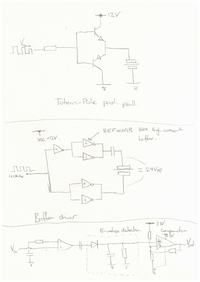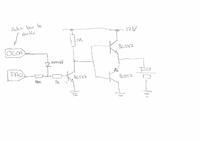mlodyfn
Newbie level 3
Hi,
I have made an ultrasonic range meter but it doesn't work as I wish.
I use timer0 in CTC mode to generate 40 kHz signal, and 3 transitors for signal 40 kHz with amplitude 12 V - Transmitter part on schematic,I use non symetric power supply for amplifier so I use voltage divider for -/+ 6 V Power supply amplifier +/- 6V part on schematic. Amplifier - Microcontroller part turns voltage from amplifier to 3,6 V on ICP of microcontroller.
Problems about circuit:
-After connecting the ultrasonic sensor voltage on JP2 ( collector Q4) falls to mV but without it voltage is about 12 V.
- With connected receiver but without connected transmitter TL082 is always amplifing some signal 50 Hz
Can someone tell me where are mistakes on schematic. I'm sorry for my English ;(
I have made an ultrasonic range meter but it doesn't work as I wish.
I use timer0 in CTC mode to generate 40 kHz signal, and 3 transitors for signal 40 kHz with amplitude 12 V - Transmitter part on schematic,I use non symetric power supply for amplifier so I use voltage divider for -/+ 6 V Power supply amplifier +/- 6V part on schematic. Amplifier - Microcontroller part turns voltage from amplifier to 3,6 V on ICP of microcontroller.
Problems about circuit:
-After connecting the ultrasonic sensor voltage on JP2 ( collector Q4) falls to mV but without it voltage is about 12 V.
- With connected receiver but without connected transmitter TL082 is always amplifing some signal 50 Hz
Can someone tell me where are mistakes on schematic. I'm sorry for my English ;(


